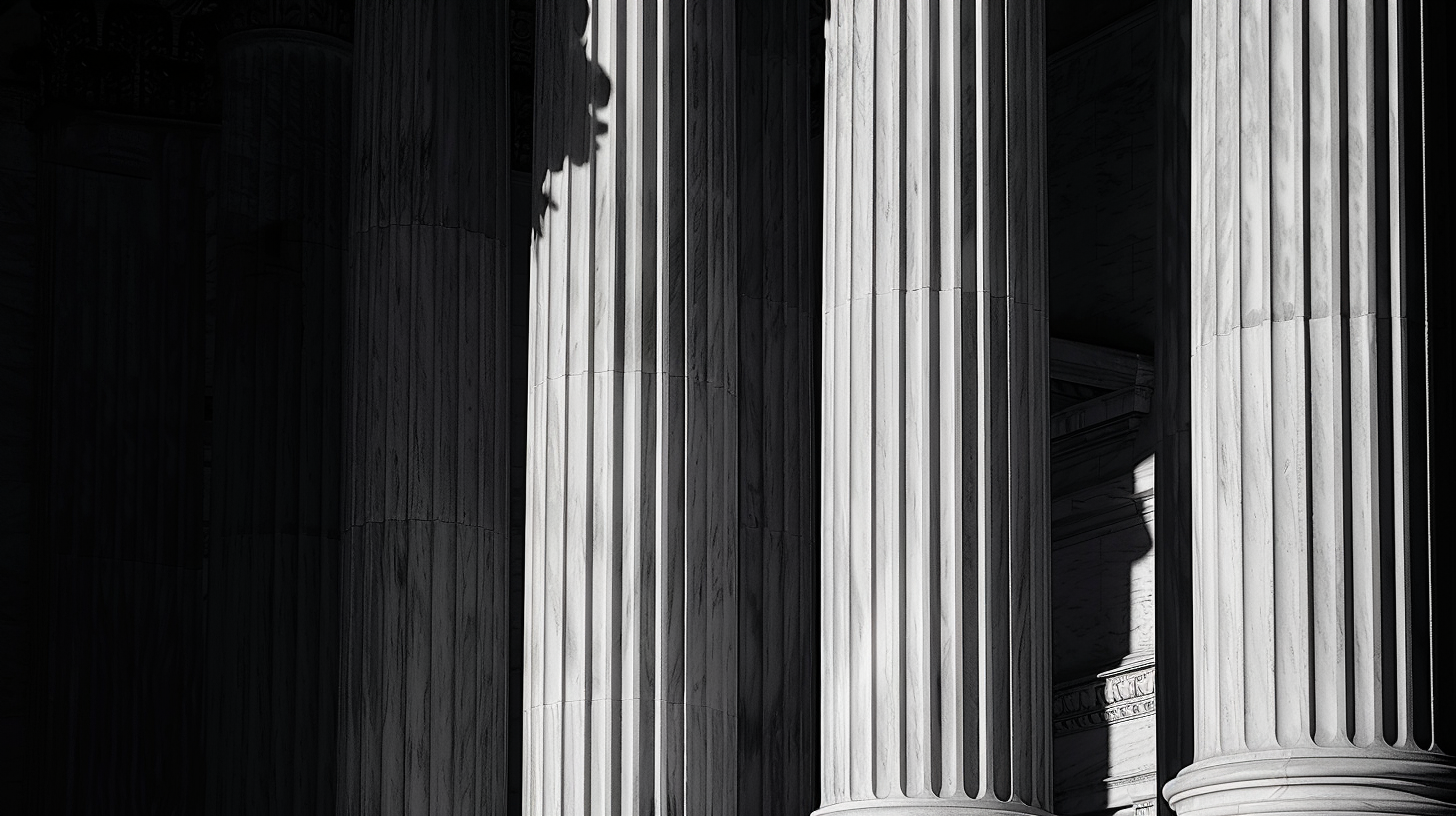Table of Contents Show
While some may argue that the Supreme Court’s role is purely judicial, we can’t ignore its profound political influence. By examining historical precedents, civil rights evolution, and shifts in social policy, we’ll uncover how these decisions not only interpret the law but also shape our political landscape. From altering the balance of power between federal and state governments to influencing electoral dynamics, the Court’s rulings have far-reaching implications. As we explore the economic impacts and consider the future of judicial philosophy, we invite you to join us in understanding the intricate ways these decisions affect our nation’s political fabric.
Key Takeaways
- Supreme Court rulings directly influence electoral dynamics and voter engagement.
- Campaign strategies and policy priorities adapt in response to court decisions.
- Decisions shape societal values and norms, impacting political narratives.
- The balance between federal and state powers affects individual liberties and governance.
Historical Precedents
Throughout history, numerous Supreme Court decisions have set pivotal precedents that continue to shape American law and society. These landmark cases aren’t just footnotes in our textbooks; they’re the backbone of our quest for freedom and justice. We’ve seen decisions that have expanded the very definition of liberty, guaranteeing that every individual’s rights are protected under the Constitution.
Take, for instance, cases like Marbury v. Madison, which established the principle of judicial review. This wasn’t just a win in the legal playbook; it was a game-changer for democracy. It meant that we, as a society, had a watchdog over the legislative and executive branches, ensuring that all laws passed muster under the Constitution’s rigorous standards for freedom and justice.
Then there’s McCulloch v. Maryland, where the Court’s ruling on federal power versus state power didn’t just outline the boundaries of governance; it safeguarded the nation’s ability to function as a cohesive unit, while still respecting the autonomy of the states. This delicate balance is vital in our ongoing quest to guarantee that freedom rings from every corner of our nation.
We’ve also witnessed decisions that have directly impacted the fabric of our society, shaping our understanding of personal liberties. While we won’t delve into the specific evolution of civil rights here, it’s clear that the Court’s role in interpreting the Constitution has been instrumental in our journey towards a more free and just society.
Civil Rights Evolution
As we turn our attention to the evolution of civil rights through the lens of Supreme Court decisions, we’ll explore landmark cases that have reshaped societal norms. We’re set to examine the far-reaching impacts these rulings have had on society. Finally, we’ll consider what future projections can be made based on current trends and past decisions.
Landmark Cases Overview
The evolution of civil rights in the United States has been greatly shaped by a series of landmark Supreme Court decisions. These rulings have not just redefined the legal landscape but have also underscored our collective journey towards a more inclusive and equitable society. They serve as beacons of progress in our ongoing quest for freedom and justice for all.
To engage you further, here are three pivotal cases:
- Brown v. Board of Education (1954): Overturned racial segregation in schools.
- Loving v. Virginia (1967): Invalidated laws prohibiting interracial marriage.
- Obergefell v. Hodges (2015): Guaranteed the right to same-sex marriage nationwide.
These milestones reflect our shared commitment to dismantling barriers and affirming the dignity of every individual.
Societal Impacts Examined
Moving beyond landmark cases, let’s examine how these Supreme Court decisions have reshaped society and propelled the evolution of civil rights. Through their rulings, the Court hasn’t just interpreted the law; it’s actively participated in the dynamic process of expanding freedoms and ensuring justice for all. We’ve witnessed a remarkable journey from segregation to equal rights, from gender discrimination to broader inclusivity. These decisions have not only reflected our growing understanding of equality but have also pushed us to confront our biases and work towards a more just society. They’ve sparked dialogue, inspired movements, and challenged us to live up to the ideals of freedom and equality. It’s clear that the Court’s influence extends far beyond the courtroom, deeply affecting the fabric of our lives and continuously shaping our pursuit of liberty.
Future Projections Considered
Looking ahead, we can anticipate that Supreme Court decisions will continue to play a pivotal role in the evolution of civil rights, shaping our society in profound ways. The court’s rulings have historically been landmarks that either propel us forward or set us back in our quest for freedom and equality. As we look to the future, it’s essential we stay informed and active in advocating for decisions that reflect our values of liberty and justice for all.
- Vigilance in Voting Rights: Ensuring fair access and representation in our democracy.
- Protection of Privacy: Safeguarding personal freedoms in the digital age.
- Equality for All: Expanding rights and protections for marginalized communities.
We’re in this together, fighting for a future where every individual’s rights are recognized and respected.
Federal Vs. State Powers
In analyzing Supreme Court decisions, we must consider how they often delineate the boundaries between federal and state powers. These landmark rulings not only define the scope of government authority but also directly impact our freedoms. As we delve into these decisions, it’s important to recognize the delicate balance that’s being navigated.
The tug-of-war between federal and state powers isn’t just legal jargon; it’s about ensuring that power isn’t concentrated too heavily in one area. This balance is important for maintaining our liberties. When the federal government oversteps, it can threaten the autonomy of states to govern in a way that best suits their citizens. Conversely, if states wield too much unchecked power, it could lead to a patchwork of laws that undermine national unity and individual rights.
We’ve seen cases where the Supreme Court has had to step in to uphold state sovereignty, ensuring that states have the room to enact policies reflecting the values and needs of their people. Similarly, there have been instances where the Court has reinforced federal authority to protect fundamental rights and guarantee nationwide consistency.
These decisions aren’t just about legal principles; they’re about preserving a system of government that cherishes freedom. By carefully balancing federal and state powers, the Supreme Court plays a pivotal role in safeguarding our liberties. It’s a reminder that in our pursuit of freedom, vigilance and an understanding of these legal boundaries are important. The implications of these rulings extend far beyond the courtroom; they shape the very fabric of our society.
Electoral Dynamics
We’re now turning our attention to how Supreme Court decisions impact electoral dynamics, specifically focusing on voter behavior shifts, campaign strategy adjustments, and policy prioritization changes. It’s important to understand how these decisions can reshape the political landscape, influencing both the strategies of campaigns and the priorities of policymakers. By analyzing these effects, we can gain insights into the broader implications of court rulings on the electoral process.
Voter Behavior Shifts
Supreme Court decisions often trigger significant shifts in voter behavior, influencing electoral dynamics across the country. These landmark rulings can fundamentally alter the political landscape, prompting us to reassess our positions and how we engage in the democratic process. As advocates for freedom, it’s vital we comprehend these changes and adapt to make sure our voices remain heard.
- Voters may feel empowered or disenfranchised, leading to increased or decreased turnout.
- Key issues become central to election narratives, affecting party platforms.
- Political engagement shifts, with more individuals participating in activism and advocacy.
Recognizing these dynamics allows us to navigate the evolving political terrain more effectively, ensuring that our commitment to freedom and democratic participation is reflected in our actions and choices at the polls.
Campaign Strategy Adjustments
Understanding the impact of Supreme Court decisions on voter behavior, it’s now important to explore how campaign strategies are adjusted in response to these shifts in electoral dynamics. We see campaigns keenly analyzing these decisions to align their messaging with the evolving values and concerns of the electorate. This means reevaluating platforms, slogans, and even the focus of their political advertisements. We’re adapting by emphasizing issues that resonate more due to recent rulings, ensuring our outreach efforts speak directly to what’s at stake for voters seeking to safeguard their freedoms. It’s a dynamic process, where staying ahead means constantly recalibrating our strategies to not only reflect current legal landscapes but also to anticipate how these changes shape the aspirations and worries of those we aim to represent.
Policy Prioritization Changes
As Supreme Court decisions reshape the political landscape, campaigns must prioritize policies more strategically to align with the evolving concerns of voters. It’s essential we adapt quickly, ensuring our policy proposals resonate deeply with what people care about most. This isn’t just about winning votes; it’s about preserving freedom and ensuring our governance reflects the will and needs of the people.
To engage our audience further, consider these key areas:
- Voter Rights Protection: Ensuring every voice is heard and counted.
- Privacy and Personal Freedoms: Safeguarding individual liberties against overreach.
- Economic Empowerment: Promoting policies that foster independence and prosperity for all.
Social Policy Shifts
When analyzing Supreme Court decisions, it’s clear they often lead to significant shifts in social policy. These landmark rulings not only reflect our societal values at a given time but also push us toward reimagining what freedom truly means in our lives. As we explore these shifts, we recognize the profound impact they have on the fabric of our society, shaping how we comprehend and interact with one another.
We’ve seen decisions that extend rights to communities that were previously marginalized, signaling a broader acceptance and inclusion within our society. These rulings often ignite discussions in our homes, workplaces, and public spaces, challenging us to confront our biases and advocate for a more equitable world. It’s through these conversations that we find ourselves participating in the ongoing evolution of our social policies, driven by a desire for justice and equality.
Furthermore, these decisions serve as a reminder of the dynamic nature of freedom. They highlight the fact that our pursuit of liberty and justice is an ever-evolving journey, not a destination. We’re compelled to examine the ways in which our laws and policies either support or hinder the collective well-being of our people.
Economic Implications
Beyond the societal shifts, Supreme Court decisions also carry profound economic implications, affecting businesses and individuals alike. These rulings can shift the landscape of our economy, opening new doors for some while imposing barriers for others. We’ve seen time and again how a single decision can ripple through the economic fabric of our nation, influencing not just the immediate stakeholders but also setting a precedent that shapes future business practices and regulatory environments.
Consider the following:
-
Market Dynamics: Supreme decisions often directly impact the way markets operate. For instance, rulings on antitrust laws can either foster a more competitive environment or, conversely, allow for greater monopolization. Such decisions don’t just affect the big players but also have a trickle-down effect on consumers and small businesses, influencing prices, availability of goods and services, and innovation.
-
Investment and Expansion: The court’s stance on regulations can make or break investment climates. A ruling that lowers regulatory hurdles can encourage both domestic and foreign investments, spurring economic growth and job creation. Conversely, increased regulation can slow down expansion plans and make investors think twice.
-
Labor and Employment: Supreme Court decisions on labor laws and workers’ rights have a significant impact on employment practices. These rulings determine minimum wage levels, union powers, and workplace conditions, directly impacting the workforce’s financial well-being and productivity.
We’re all stakeholders in these decisions. They don’t just shape our legal landscape but also determine the economic freedoms and constraints we navigate. As we champion for a future that values freedom, it’s important we stay informed and engaged with the economic implications of the Supreme Court’s decisions.
Judicial Philosophy
Delving into the domain of judicial philosophy, we uncover the foundational beliefs that guide justices in their interpretation and application of the law. This essential aspect shapes how our highest court influences the political landscape, making it vital for those of us who value freedom and seek to understand the mechanisms that safeguard or challenge it.
Judicial philosophies, such as originalism or living constitutionalism, serve as the backbone for decision-making on the Supreme Court. Originalists argue that the Constitution should be interpreted as it was understood at the time it was written, offering a stable, unchanging base for legal decisions. Meanwhile, proponents of living constitutionalism believe that the Constitution’s meaning can evolve to meet the needs of contemporary society. This dynamic interplay between stability and adaptability often dictates the direction of our nation’s laws and, by extension, our liberties.
We also see a distinct impact on individual rights through these philosophies. For instance, decisions regarding free speech, the right to privacy, and the limits of governmental power hinge on how justices interpret the Constitution. Thus, the philosophical leanings of the Supreme Court can either fortify or erode the freedoms we hold dear.
Understanding judicial philosophy isn’t just an academic exercise; it’s a necessary step for anyone committed to protecting our freedoms. By grasping the principles that guide our justices, we equip ourselves with the knowledge to advocate for a judicial system that respects and upholds the liberties enshrined in our Constitution.
Future Political Landscapes
The evolving judicial philosophies of the Supreme Court will certainly shape the future political landscapes in profound ways. As we look ahead, it’s clear that the decisions made today will ripple through time, affecting generations to come. We’re maneuvering at a crossroads, where each ruling not only interprets the law but also sets a precedent that guides our nation’s principles and priorities.
In envisioning the future, we must consider how these judicial decisions will influence our political, social, and economic environments. The Supreme Court’s role in shaping policy through its interpretations of the Constitution cannot be understated. It’s more than just a judicial body; it’s a pivotal force in directing the nation’s course.
To engage more deeply, let’s highlight some key areas we’re closely watching:
-
Civil Liberties and Rights: The Court’s stance on issues such as freedom of speech, privacy, and equal protection under the law will define the boundaries of individual freedoms and government powers.
-
Healthcare and the Environment: Decisions affecting healthcare access and environmental regulations have far-reaching impacts on public welfare and our responsibility towards future generations.
-
Electoral Politics: How the Court handles cases related to voting rights, redistricting, and election laws will have a direct impact on the democratic process and the fairness of our elections.
We’re maneuvering a complex landscape, where the Supreme Court’s interpretations of the law intersect with the aspirations of a society yearning for freedom, equality, and justice. The decisions made by the Court will not only reflect our current values but also shape the political contours of our future.
Conclusion
In our exploration, we’ve seen how Supreme Court decisions shape the political terrain like rivers carving through rock—slowly but irrevocably. From historical precedents to future landscapes, these rulings influence everything from civil rights to economic policies. They underscore the tension between federal and state powers, while also reflecting changes in societal values and judicial philosophies. As we look ahead, it’s clear that the Court’s decisions will continue to play a pivotal role in defining the contours of American democracy.








